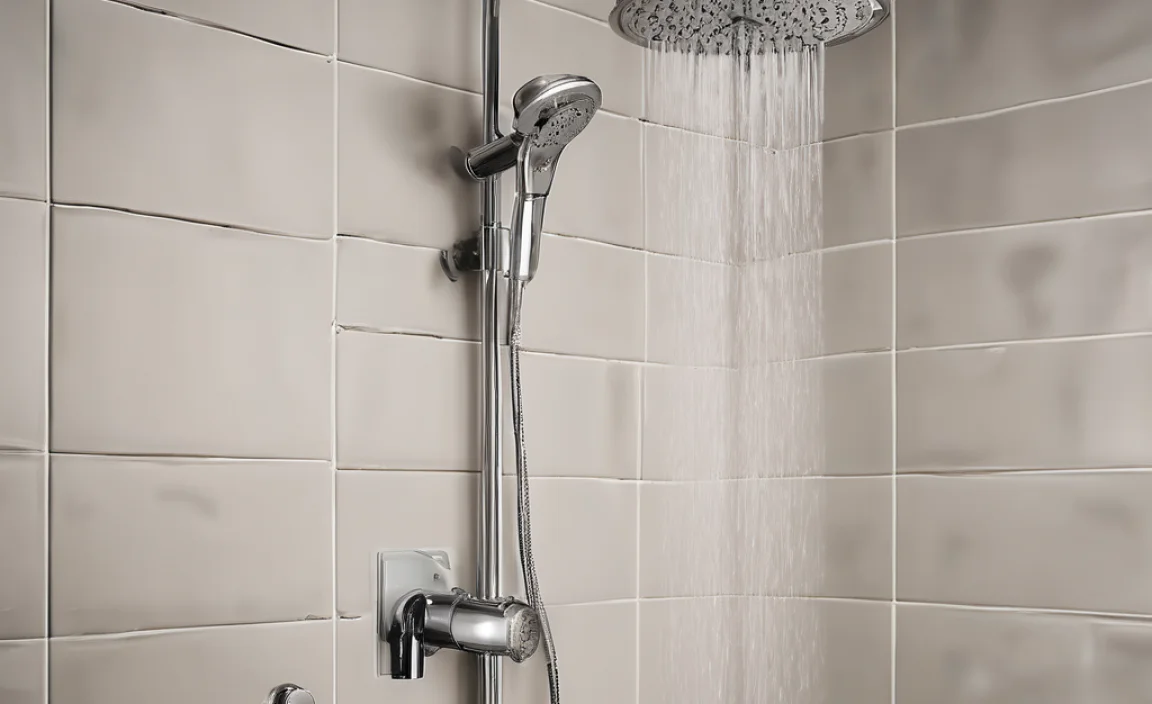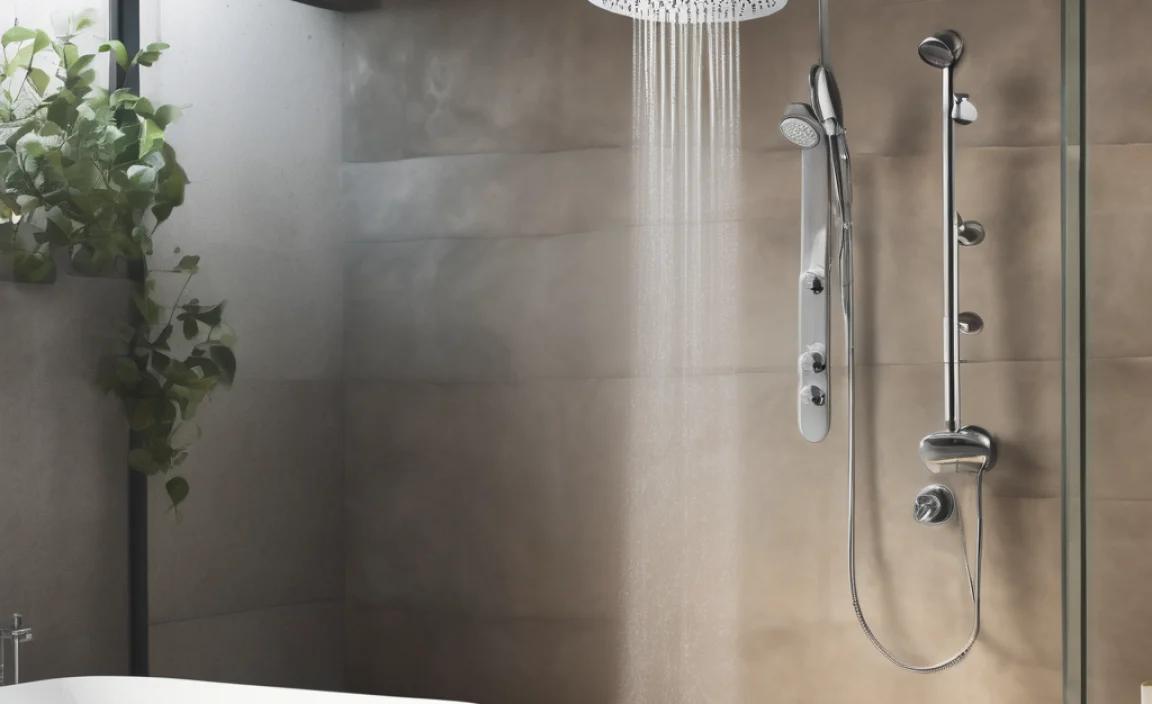Quick Summary: Thermostatic showers keep your water temperature steady, so you don’t get scalded or frozen when someone else uses water in the house. They use a special valve that mixes hot and cold water automatically to maintain the temperature you set. This means a safer and more comfortable shower every time!
Have you ever been enjoying a nice, warm shower when suddenly the water turns ice cold or, even worse, scalding hot? It’s usually because someone flushed a toilet or turned on the washing machine. This can be really annoying and even dangerous! Luckily, there’s a solution: thermostatic showers. These showers are designed to keep your water temperature consistent, no matter what else is happening in your home. Let’s dive into how they work and why they’re a great choice for your bathroom.
What Exactly Are Thermostatic Showers?

Thermostatic showers are a type of shower system that uses a special valve to control the water temperature. Unlike regular showers where you manually adjust the hot and cold taps, thermostatic showers do it automatically. This valve, called a thermostatic mixing valve (TMV), blends hot and cold water to reach and maintain your desired temperature. It reacts quickly to changes in water pressure or temperature, keeping your shower consistent and safe.
Key Components of a Thermostatic Shower
To really understand how thermostatic showers work, let’s break down the main parts:
- Thermostatic Mixing Valve (TMV): This is the heart of the system. It mixes hot and cold water to the temperature you set.
- Temperature Control: A dial or button that lets you set your preferred water temperature.
- Flow Control: This controls the water pressure or flow rate of the shower.
- Showerhead: The part that delivers the water, which can be fixed, handheld, or a rain shower type.
- Inlets: Connections for both hot and cold water supplies.
These components work together to give you a consistent and safe showering experience. No more sudden temperature changes!
How Do Thermostatic Showers Work?

The magic of a thermostatic shower lies in its mixing valve. Here’s a step-by-step look at how it works:
- Setting the Temperature: You set your desired temperature using the control dial.
- Water Mixing: The TMV automatically mixes hot and cold water based on your setting. A sensor inside the valve constantly monitors the water temperature.
- Adjusting the Mix: If the water temperature starts to change (e.g., due to someone using water elsewhere), the TMV adjusts the mix of hot and cold water to compensate.
- Maintaining Consistency: The valve continues to make these adjustments in real-time, ensuring the water temperature stays within a degree or two of your setting.
- Safety Shut-Off: Most TMVs have a safety feature that shuts off the water if the cold water supply fails. This prevents scalding.
This automatic adjustment is what makes thermostatic showers so reliable and safe.
Benefits of Thermostatic Showers

Why should you consider installing a thermostatic shower? Here are some compelling reasons:
- Consistent Temperature: Say goodbye to sudden bursts of hot or cold water.
- Safety: The anti-scald feature is especially important for families with children or elderly individuals.
- Comfort: Enjoy a relaxing shower without worrying about temperature fluctuations.
- Water Efficiency: Some models come with flow regulators, helping you save water.
- Customization: Available in various styles and finishes to match your bathroom decor.
These benefits make thermostatic showers a popular choice for modern bathrooms.
Types of Thermostatic Showers

Thermostatic showers come in different styles to suit various needs and preferences. Here are a few common types:
- Exposed Thermostatic Showers: The valve is mounted on the wall, making it easy to install and access for maintenance.
- Concealed Thermostatic Showers: The valve is hidden behind the wall, giving a cleaner, more minimalist look.
- Digital Thermostatic Showers: These showers use digital controls to set and monitor the temperature, often with added features like pre-set temperatures and timers.
- Thermostatic Shower Panels: These include the valve, showerhead, and body jets all in one unit, offering a luxurious shower experience.
Each type has its own advantages, so consider your bathroom layout and personal style when choosing.
Choosing the Right Thermostatic Shower

Selecting the perfect thermostatic shower involves considering several factors. Here’s what to keep in mind:
- Water Pressure: Check the minimum water pressure required for the shower to function properly. Some models are designed for low-pressure systems.
- Installation: Decide whether you want an exposed or concealed valve. Concealed valves require more extensive plumbing work.
- Features: Look for features like anti-scald protection, flow regulators, and digital controls.
- Style: Choose a style and finish that complements your bathroom decor.
- Budget: Thermostatic showers range in price, so set a budget before you start shopping.
By considering these factors, you can find a thermostatic shower that meets your needs and preferences.
Installation Guide: How to Install a Thermostatic Shower
Installing a thermostatic shower can be a DIY project if you’re comfortable with plumbing. If not, it’s always best to call a professional. Here’s a general guide to help you through the process:
Tools You’ll Need
- Adjustable wrench
- Screwdrivers (Phillips and flathead)
- Pliers
- Level
- Pipe cutter
- Pipe tape or sealant
- Drill (if mounting on tile)
- Safety glasses
- Gloves
Step-by-Step Installation
- Turn Off the Water: Shut off the main water supply to your house.
- Remove Old Shower Fixtures: Disconnect and remove your old showerhead and valve.
- Prepare the Wall: If installing a concealed valve, you may need to open up the wall to access the plumbing.
- Connect the Water Supply: Connect the hot and cold water pipes to the thermostatic mixing valve. Use pipe tape or sealant to ensure a watertight connection.
- Mount the Valve: Secure the valve to the wall according to the manufacturer’s instructions. Use a level to ensure it’s straight.
- Install the Showerhead: Attach the shower arm and showerhead to the valve.
- Test the Shower: Turn the water back on slowly and check for leaks. Adjust the temperature and flow to ensure everything is working correctly.
- Finish the Installation: If you opened up the wall, repair and finish the surface.
Remember to always follow the manufacturer’s instructions for your specific model. If you’re unsure about any step, consult a professional plumber.
Maintaining Your Thermostatic Shower
To keep your thermostatic shower working smoothly, regular maintenance is key. Here are some tips:
- Clean Regularly: Wipe down the showerhead and valve with a mild cleaner to prevent buildup.
- Check for Leaks: Inspect the connections regularly for any signs of leaks.
- Descale the Showerhead: Mineral buildup can reduce water flow. Soak the showerhead in vinegar to remove scale.
- Service the Valve: If you notice temperature fluctuations or reduced flow, the valve may need servicing. Consult a plumber for professional maintenance.
By following these tips, you can extend the life of your thermostatic shower and keep it performing at its best.
Troubleshooting Common Issues
Even with proper maintenance, you might encounter some issues. Here are a few common problems and how to address them:
| Issue | Possible Cause | Solution |
|---|---|---|
| Water is too hot or too cold | Incorrect temperature setting, faulty TMV | Adjust the temperature setting, consult a plumber to check the TMV |
| Low water pressure | Clogged showerhead, Low water pressure in the house | Clean or replace the showerhead, check your home’s water pressure |
| Shower won’t turn on | Water supply is off, valve is blocked | Check the water supply, clean the valve |
| Leaking showerhead or valve | Loose connections, worn-out parts | Tighten connections, replace worn-out parts |
If you can’t resolve the issue yourself, it’s best to call a qualified plumber.
Cost Considerations
The cost of a thermostatic shower can vary widely depending on the type, brand, and features. Here’s a general breakdown:
- Thermostatic Mixing Valve (TMV): $50 – $300
- Exposed Thermostatic Shower Set: $100 – $500
- Concealed Thermostatic Shower Set: $200 – $1000+
- Digital Thermostatic Shower: $500 – $2000+
- Installation Costs: $100 – $500+ (depending on complexity)
While the initial cost may be higher than a standard shower, the added safety and comfort can be well worth the investment. Plus, you’ll save money on potential scalding-related injuries!
Thermostatic vs. Electric Showers: What’s the Difference?
It’s easy to confuse thermostatic and electric showers, but they work very differently:
| Feature | Thermostatic Shower | Electric Shower |
|---|---|---|
| Water Source | Uses hot and cold water from your home’s supply | Heats cold water on demand using an internal heating element |
| Temperature Control | Maintains a consistent temperature by mixing hot and cold water | Temperature depends on the power setting and water flow rate |
| Water Pressure | Requires adequate water pressure from your home’s supply | Can operate at lower water pressure |
| Installation | Requires access to both hot and cold water pipes | Requires only a cold water supply and electrical connection |
| Safety | Anti-scald feature prevents sudden temperature changes | Risk of scalding if the power setting is too high or water flow is too low |
Electric showers are a great option if you don’t have access to a hot water supply, but thermostatic showers offer superior temperature control and safety.
Safety Standards and Certifications
When choosing a thermostatic shower, look for products that meet safety standards and have relevant certifications. These certifications ensure that the shower has been tested and meets certain performance and safety criteria. Here are some key standards to look for:
- ASME A112.18.1/CSA B125.1: This standard covers plumbing supply fittings and includes requirements for thermostatic mixing valves.
- ASSE 1016: This standard specifically addresses performance requirements for individual thermostatic mixing valves.
- WRAS (Water Regulations Advisory Scheme): This certification in the UK ensures that the product complies with water regulations and is safe to use with potable water.
- EN 1111: A European standard for thermostatic mixing valves, specifying performance and safety requirements.
Checking for these certifications can give you peace of mind knowing that you’re investing in a safe and reliable product. Always verify that the product’s certifications are current and valid.
Smart Thermostatic Showers: The Future of Showering
As technology advances, so do our shower systems. Smart thermostatic showers are the latest innovation, offering enhanced control and convenience. These showers often include features such as:
- Digital Displays: Showing the current water temperature and allowing precise adjustments.
- Smartphone Connectivity: Control your shower settings from your phone, set timers, and even preheat the water before you step in.
- Voice Control: Use voice commands to start, stop, and adjust your shower settings.
- Customizable Profiles: Save your preferred temperature and flow settings for different users.
- Water Usage Monitoring: Track your water consumption to help conserve water and reduce your bills.
While smart thermostatic showers come with a higher price tag, they offer a level of customization and convenience that traditional showers can’t match. They are perfect for tech-savvy homeowners looking to create a luxurious and efficient bathroom experience.
FAQ About Thermostatic Showers
Here are some frequently asked questions about thermostatic showers:
- Q: Are thermostatic showers safe for children?
- A: Yes, thermostatic showers are very safe for children because of their anti-scald feature. This prevents the water from getting too hot suddenly, protecting kids from burns.
- Q: Can I install a thermostatic shower myself?
- A: If you’re comfortable with plumbing, you can install an exposed thermostatic shower. Concealed valves are more complex and often require a professional plumber.
- Q: Do thermostatic showers save water?
- A: Some thermostatic showers come with flow regulators that help conserve water. Look for models with this feature to save on your water bill.
- Q: How do I clean my thermostatic showerhead?
- A: You can clean your showerhead by soaking it in vinegar to remove mineral buildup. This helps maintain good water flow.
- Q: What if my thermostatic shower isn’t maintaining the temperature?
- A: If your shower isn’t maintaining the temperature, the TMV may need servicing. Contact a plumber to check and repair the valve.
- Q: Are thermostatic showers suitable for low water pressure systems?
- A: Some thermostatic showers are designed for low water pressure. Check the product specifications to ensure it’s compatible with your system.
- Q: How long do thermostatic showers typically last?
- A: With proper maintenance, a good quality thermostatic shower can last for 10-15 years or even longer. Regular cleaning and occasional servicing will help extend its lifespan.
Conclusion
Thermostatic showers are a fantastic upgrade for any bathroom, offering consistent temperature, safety, and convenience. Whether you choose an exposed, concealed, or digital model, you’ll enjoy a more comfortable and worry-free showering experience. By understanding how they work, considering the different types available, and following our installation and maintenance tips, you can choose the perfect thermostatic shower for your home. So go ahead, make the switch, and say goodbye to those unexpected bursts of hot and cold water!


